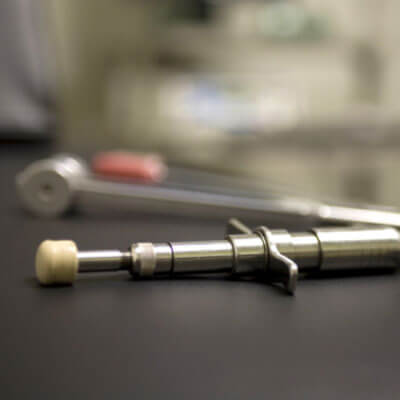What is Low-Force Chiropractic?
 There have been many doctors that have written about the subject of low-force chiropractic and the common theme carries the following premises: low-force is only to be used on certain patients, it is only beneficial for certain demographics and body types, it is ancillary to higher force, and it “has its place.” As a low-force chiropractic specialist who uses a similar technique – Reflex Activated Leg Technique (Re.A.L.™) – as the original low-force technique, Directional Non-Force Technique (D.N.F.T.), the above descriptions are not accurately defining of what low-force chiropractic is.
There have been many doctors that have written about the subject of low-force chiropractic and the common theme carries the following premises: low-force is only to be used on certain patients, it is only beneficial for certain demographics and body types, it is ancillary to higher force, and it “has its place.” As a low-force chiropractic specialist who uses a similar technique – Reflex Activated Leg Technique (Re.A.L.™) – as the original low-force technique, Directional Non-Force Technique (D.N.F.T.), the above descriptions are not accurately defining of what low-force chiropractic is.
To break down the two general categories of technique in chiropractic; you have higher force and lower force; It is that simple. There are currently over 150 chiropractic techniques and usually you learn less than ten in chiropractic schooling. So, what about all the others? Bear in mind that some of these techniques are not taught simply because of resources. To get a technique into a school beyond an elective or club level, schools want money. The minimum can be quite high and a doctor who has developed a phenomenal technique from clinical experience may not have the resources to make this happen.
The original low-force technique was developed by Dr. Richard VanRumpt in 1924 called Directional Non-Force Technique, or D.N.F.T.™ Dr. VanRumpt had an analysis specific for low-force adjusting that used the Reactive Leg and the Reactive Leg Reflex. These were specific to D.N.F.T.™ and no other doctor had been using a neurological-based leg check. Every leg check currently used in chiropractic came after this with the original thoughts of Dr. VanRumpt’s leg check, but modified it to create something new so another doctor could put their name on it. This is the original neurological based leg check. Activator™ leg check and Torque Release Technique™ are two techniques that developed leg checks which came after and are modified versions of the original.
What makes D.N.F.T.™ so different from high-force techniques is the adjusting thrust. The thumb thrust that is used by D.N.F.T.™ and Re.A.L.™ technique doctors has no extremity movement as the thrust is performed. The thrust is pure kinetic energy impulse, not manual movement of the hand. This means that the doctor is not “moving the segmental contact point (the portion of the doctor’s hand that contacts the patient’s body)” to “cavitate (crack)” a joint. The joint may cavitate still, yet it is done by the thrust impulse, not the manual movement of the joint by manual movement of the thrusting hand. The technique also incorporates muscle and ligament work and can still be used even when the muscles are in spasm.

You will find prolific content about low-force being situational, spotty in its results, or patient-dependent. The truth is that higher force adjusting meets this description much more than lower force. There are many contraindications for a high-force adjustment, which do not exist in a low-force adjustment. Low-force adjusting can be safely performed on almost anyone (fractures are not to be directly adjusted). The major contraindication to a low-force adjustment is during a medical emergency where the patient should be immediately referred to the E.R. After they are discharged, they can go get a low-force adjustment.
The reason some get good results with low-force adjusting by a typical chiropractor, and some don’t is the diagnosis. If the doctor is using the same methods to diagnose a patient that they learn in high-force technique classes, they will not adjust with low-force as effectively. In many cases they adjust what is called compensation. When compensation is adjusted, the subluxation will return since the body is the cause of the compensation; because the body attempted to correct the problem on its own. Some doctors claim they can feel the neurological interference better than others via palpation. However, many chiropractors are looking for structural signs, muscle tone, temperature, skin changes, and pain. With low-force adjusting, these objective signs will yield less than favorable results more often than not. There is still intention energy passed through an adjustment which means many will receive some healing benefit, but it will not hold long or help in more complex cases.

Last but not least, low-force chiropractic adjustments work best over the next 24 hours post-adjustment. It is important to hydrate, eat as best you can, and take it easy. This period is a vulnerable period to traumatically reverse the adjustments benefit. For example, if you go and do a high-intensity workout you could reverse the adjustment’s healing benefits. Manual labor could do this as well. It depends on the patient and the physical capabilities, tolerance, and all that was adjusted. Sometimes life is too busy to allow for the ideal rest over the 24 hours, but being careful with posture, biomechanics, and how much we do is feasible in most situations. In those 24 hours the body will have restored communication and be able to facilitate the regulatory and healing processes it was not capable of doing before due to neurological interference (subluxation). So, the patient may not feel their best until after the 24 hours following an adjustment.
Learn More Today
Want to learn more about low-force chiropractic adjustments or experience the benefits first hand? Give us a call at (319) 304-6317 or email us at docjotto@chirolowforce.com. We would love to discuss this further.
